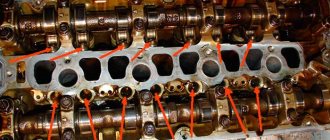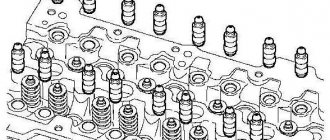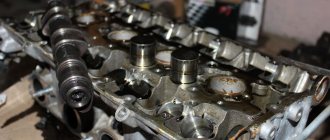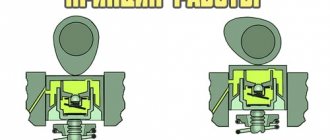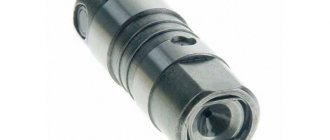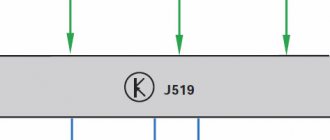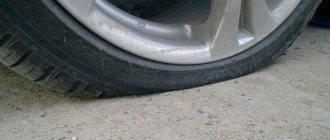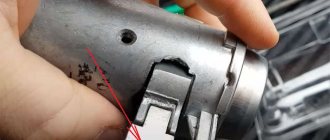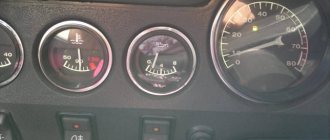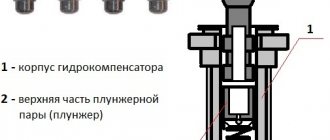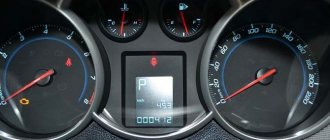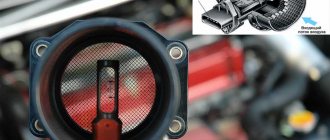Hydraulic valve thermal clearance compensators do all the dirty work for us in adjusting the clearance between the valve and the camshaft (pushrod, rocker). However, if you treat the engine carelessly, the knocking of hydraulic lifters can really ruin your mood and cause problems. Is it possible to drive with knocking pushers, how to get rid of the knocking and what to do to increase the service life, repair or buy hydraulic compensators, we’ll look at these subtleties right now.
Clattering, clanging, tapping tappets are only the first signal that something is wrong with the engine. The knock of the hydraulic compensator is like a litmus test for the condition of the lubrication system, and indeed the entire engine. Visually we cannot judge the degree of oil wear or the cleanliness of the oil channels. The instruments on the panel won’t say anything either - the pressure and level are fine, which means everything is fine. A hydraulic compensator of any design is a finely tuned plunger device that will respond to any negative changes in the lubrication system.
The knocking sound of the hydraulic compensator may indicate other problems in the engine.
- high fuel consumption; severe loss of power; engine overheating is possible; If you delay repairs, the valves or piston crown will easily burn out.
In short, if a knocking noise occurs, it is advisable to carry out diagnostics and repairs as soon as possible.
A burnt valve is a consequence of knocking hydraulic compensators
The knocking of hydraulic valves on a warm and cold engine can indicate various malfunctions and problems. However, there are no troubles that cannot be corrected. Cold hydraulic tappets can make a clicking noise for a number of simple reasons:
- The problem is with the hydraulic compensator itself
. Hydraulics are a thin device that has its own resource, and if they have lasted more than 50-70 thousand, most likely it will be necessary to replace the hydraulic compensators. However, there is a possibility that the hydraulic compensator is simply coked. In this case, it can be washed, inspected and a conclusion about the condition can be drawn. Treatment without disassembling the head is impossible in this case. - Oil problem
. If we know that the oil life is already running out, after the replacement the car has traveled more than 5-7 thousand, the knocking of the hydraulic compensators will be caused by oil wear. It loses its characteristics and only begins to harm the engine - it loses viscosity, clogs the oil channels and clogs the oil filter. Hydraulics also suffer from dirty old oil, so it needs to be changed urgently before we ruin the engine. - Hydraulic compensator bypass valve.
After stopping the engine, the pumped oil should remain in the hydraulic compensator housing. It is held in place by a ball valve so that the next time the plunger is started, it does not wait for a new portion of oil, but immediately gets to work. Therefore, the knocking of the hydraulic compensator when cold, although it does not knock when hot, may indicate a clogged or worn hydraulic pusher valve. The solution to the problem is to bleed the hydraulic compensator or replace it if it fails. - Clogged, coked oil channels. Both in the block head and in the hydraulics itself. The optimal solution is mechanical cleaning of the channels with disassembly of the block head. Some drivers use all sorts of chemicals, there are oil additives that should restore the performance of hydraulics. But miracles do not happen, and with an additive, at best, we will delay the inevitable cleaning of the compensator channels or the head itself.
- The brand and viscosity of the oil does not correspond to the operating conditions of the engine . It may be too viscous or too runny. In both cases, the hydraulic compensators will react first.
- Clogged oil filter . It changes along with the oil, so after replacing both, the knocking when cold may stop.
With this condition of the engine, the knocking of the hydraulic compensators is a gift of fate
- The oil has exhausted its resource. As in the case of knocking when cold, we change the oil along with the filter if the mileage after replacement is 5-7 thousand.
- Hydraulic valves are clogged. In this case, when cold, there may be no knocking, but when the body, plunger and pusher valve heat up and expand, oil may not enter the body at a certain warm-up temperature. The solution is to clean the hydraulic compensators.
- Oil level. If the oil level is below normal, the oil pump will not physically be able to supply it to the furthest points of the lubrication system. True, this should be signaled by a pressure or level indicator lamp. In any case, check the oil level and bring it to normal.
- Pressure . The oil pump is not able to develop the required oil pressure. As in the previous case, this threatens to air the compensators. Check the oil level and pressure. It is possible that the oil pump is worn out, or the oil pump pressure reducing valve has failed, or the receiving screen is clogged.
- Mechanical damage hydraulic compensator or its installation location. This can only be determined after removing the valve cover and carefully inspecting the gas distribution mechanism.
A drop in oil pressure cannot be ignored!
It happens that after a complete replacement of the hydraulics, a knocking sound will be heard when the engine is first started. This is quite normal, since the pushers need to get used to. Nevertheless, the knocking should disappear after 100-200 km. If the new hydraulics continue to rattle, it's not their fault. This is precisely why it is very important to be able to buy hydraulic compensators with a guarantee, from a good manufacturer and from a reliable seller.
If installed incorrectly, the new hydraulic compensator may also knock.
In addition, the knocking sound of new hydraulic compensators, just purchased, may be caused by their incorrect installation. For example, we made a mistake and did not push the hydraulic valve all the way into the well, the oil channel of the block head did not coincide with the inlet hole of the compensator, as a result, the oil did not enter the housing, and the compensator cannot physically work. Alternatively, when the new compensators knock, the oil channels are clogged and the oil does not get access to the hydraulics.
To diagnose a hydraulic compensator, you don’t need to go to a service station and pay extra money. The signs of its malfunction are so obvious that we will determine them ourselves. Before checking the hydraulic compensator, we will find a probe or a set of probes with a thickness of 0.01-0.5 mm. We remove the valve cover and find any open timing valve - the camshaft cam should be facing up. We insert a feeler gauge between the bottom of the cam and the hydraulic valve; if the gap is greater than 0.1 mm , the compensator does not work, it needs to be pumped, repaired or replaced.
Checking the hydraulic compensator by pushing
You can more accurately check the hydraulic compensator removed from the head. If we manage to push the hydraulic guide with our hands, it will fail and squeeze out, and the malfunction is obvious. In this case, we will change the compensator or try to restore it, it all depends on the design of the specific hydraulic unit.
Not every expansion joint can be repaired, but sometimes replacement can be delayed. This is especially true in cases where it is not possible to buy a hydraulic compensator of a suitable type from a catalogue. There are at least three ways to restore the pusher:
- Washing with a special composition . The best composition for washing hydraulic compensators is considered to be Liqui Moly Hydro-Stossel-Additiv. Its price is about $12, it will help flush the compensator channels and the oil channels of the cylinder head. It is used to flush the lubrication system with both new oil and old (preferably): pour 300 ml (per 6 liters of oil) Liqui Moly Hydro-Stossel-Additiv into the engine, after a run of 700-1000 km, drain and change the oil and filter . If the problem is coking of the channels, it helps in 90% of cases.
Liqui Moly Hydro-Stossel-Additiv, use at your own peril and risk - Flushing the lubrication system using the standard method when changing oil and filter. Not everyone likes flushing compounds, so whether to use this method or not is a matter of conviction.
The best option is mechanical manual cleaning and washing - Mechanical cleaning works most effectively . Yes, we will have to remove and disassemble, clean and rinse the hydraulics, but we will be 100% sure of the result and will not poison the engine with chemicals, we love our car, right?
Keep an eye on the condition of the hydraulic lifters and your engine will run for hundreds of thousands of miles without problems.
Purpose and principle of operation of the hydraulic valve compensator
Anyone who has experience driving cars probably remembers the “magic number” of 10,000 as a reminder that it is time to adjust the timing belt. It was precisely this mileage that needed to be “rolled back” in order to check the gap between the camshaft cams and the valves.
p, blockquote 1,0,0,0,0 —>
p, blockquote 2,0,0,0,0 —>
For the uninformed, it should be explained that this operation is very important in order for the engine to work for a long time without losing compression and power.
p, blockquote 3,0,0,0,0 —>
p, blockquote 4,0,0,0,0 —>
Instructions for restoring the performance of hydraulic pushers
To access the hydraulic compensators, you will need to partially disassemble the gas distribution mechanism. The simplest test is to press the device with your finger - it should remain as rigid as possible. If the pressure causes the pusher to “fall through”, then the assembly is removed and washed. To do this, we suggest using the recommendations.
Required spare parts
Article numbers 2112-1007300-01 and 2112-1007300 indicate hydraulic pushers manufactured by AvtoVAZ - this is the catalog number. They need to be purchased for repairs. The price of the set is about 3,300 rubles (per piece – 220 rubles). You can also buy spare parts with article number 420007310 INA. They are suitable for replacing VAZ 2112 hydraulic compensators (16 valves), but the price of the set is higher - up to 2,700 rubles (per piece - 280 rubles). Another analogue is Herzog HL0 7300. Price 2700 rubles. The compensator Master-sport 2112-1007300-SET/16/-MS is also recommended for installation on VAZ 2110, 2111, 2112.
Tools required for repairs
To work you need to prepare the following tool:
- magnetic screwdriver;
- jack;
- a set of keys;
- rags;
- sealant or degreaser.
Independent replacement of VAZ 2110 hydraulic compensators 16 valves is completely justified economically. In car services, as of July 21, 2019, the price of repairs averages 3 thousand rubles. In addition to money, you will save personal time.
Sequence of operations
To replace the hydraulic compensators of the VAZ 2112 and other models, you need to drive the car into an inspection hole, drive onto an overpass, or lift it with a jack. It is important to ensure reliable fixation of the vehicle and sufficient illumination of the work area. Now you can start working:
- For safe work, you need to turn off the on-board power supply; to do this, disconnect the negative terminal from the battery.
- Removing the plastic engine shield - unscrew the four bolts.
Now you need to loosen the mount of the generator on the mounting plate; to do this, loosen the nut.
You need to remove the generator drive tension belt. To do this, loosen its tension by rotating the nut counterclockwise.
- Removing the engine intake manifold and receiver. The hole must be closed to prevent dirt and foreign objects from getting into them.
- Then you need to dismantle the right wheel and the plastic shield covering the engine compartment. Now use the pulley bolt to turn the crankshaft clockwise.
- The lower pulley rotates to the camshaft timing pulley mark to the antennae on the rear timing cover.
- The camshaft pulley fastenings are loosened and the timing belt is removed.
To completely dismantle the camshaft pulleys, you need to check the marks on the timing belt housing. They must line up exactly with the marks on the pulleys.Using the heads, 15 fasteners of the cylinder head cover are unscrewed.
Now twenty fasteners of the camshaft bearing housing are unscrewed.
The camshaft bearing housing is removed.
- The camshaft is completely removed, along with the seals.
- A magnetic screwdriver is applied to the end of the hydraulic pusher, so it is removed from the head socket.
New spare parts are installed in place of the old compensators in the cylinder head sockets. - The cams and bearing journals are lubricated with oil, the shafts are installed in the head supports. Note! To easily distinguish the intake camshaft from the exhaust device, there is a belt on its first journal.
- Now you need to tighten the nuts until they touch the cylinder head of the bearings. The operation is performed in a certain sequence, it is shown in the figure.
- The valve cover, timing belt and pulleys are returned to their original locations. Further operations are performed in reverse order.
For the sequence of replacing hydraulic compensators on the VAZ 2110 and other models, watch this video:
Hydraulic valve compensator - what it is and its operating principle
p, blockquote 5,0,0,0,0 —>
During operation, the temperature rises, and in this case, metal parts tend to expand. So, because of this heating, the valve rods increase, as a result of which they rest against the camshaft camshafts and do not completely close the intake and exhaust openings through which the combustible mixture enters the cylinders and exhaust gases are discharged.
p, blockquote 6,0,0,0,0 —>
Video - operating principle of the hydraulic valve compensator:
p, blockquote 7,0,0,0,0 —>
p, blockquote 8,0,0,0,0 —>
To prevent this from happening, gaps are set between the valves and the camshaft cams exactly the same amount by which the valve stems increase when heated strongly.
p, blockquote 9,0,0,0,0 —> adsp-pro-1 —>
Over time, these gaps increase, which leads to untimely delivery of the combustible mixture to the pistons and incomplete removal of gases from the combustion chambers. This not only reduces the efficiency of the engine, but also leads to its gradual failure.
p, blockquote 10,0,1,0,0 —>
Video - replacing hydraulic lifters on a Hyundai Getz:
p, blockquote 11,0,0,0,0 —>
p, blockquote 12,0,0,0,0 —>
That is why it was necessary to adjust the gaps every 10,000 km by removing the valve box cover. But it should be noted that this was not an easy matter, since there are certain rules of procedure that cannot be violated under any circumstances.
p, blockquote 13,0,0,0,0 —>
As the car began to enter the life of every second resident of our country, and knowledge of its internal structure had already lost its relevance, it was necessary to somehow resolve the issue of adjusting the gaps automatically, without the need for driver intervention. And the solution came in the form of installing hydraulic compensators.
p, blockquote 14,0,0,0,0 —>
If we talk about the device itself, it should be noted that it is configured at the factory with pinpoint precision. And this is no wonder, since even fractions of a millimeter play a significant role. The mechanism is quite complex, and the principle of its operation is to carry out actions aimed at adjusting the gap.
p, blockquote 15,0,0,0,0 —>
p, blockquote 16,0,0,0,0 —>
The hydraulic compensator is nothing more than a copy of a hand pump in a greatly reduced form. There is a ball valve inside the device through which oil flows inside from the lubrication system. With its pressure, it begins to push the piston up, reducing the gap between the cam and the valve. It must be said that this oil is supplied in strictly dosed quantities to prevent the piston from lifting by an amount greater than the gap.
p, blockquote 17,0,0,0,0 —>
After a certain period, wear occurs, due to which the gap increases again. The pressure inside the hydraulic compensator begins to drop, and the ball valve, opening slightly, lets in the required amount of oil, and the gap returns to normal. That is, it is automatically adjusted, without any outside intervention.
p, blockquote 18,0,0,0,0 —>
Video - the operating principle of hydraulic compensators:
p, blockquote 19,0,0,0,0 —>
p, blockquote 20,1,0,0,0 —>
That's basically it. You can, of course, list all the parameters and sizes, but why? For most car enthusiasts, the process itself is important, not the tactical and technical indicators. But it’s probably worth talking about the “pros” and “cons” of the mentioned devices.
p, blockquote 21,0,0,0,0 —>
pros
Hydraulic compensators extend the life of the engine, the sound of the gas distribution mechanism units is noticeably reduced. Due to the fact that the gap is virtually constant, there is no compression loss and the engine does not lose power.
p, blockquote 22,0,0,0,0 —>
In addition, there is no need to once again touch the engine components and make adjustments to the operation of the parts of the gas distribution mechanism, which is very finely tuned.
p, blockquote 23,0,0,0,0 —>
Minuses
The most significant drawback (which, however, is quite common among our car enthusiasts) is the use of only high quality motor oil, as well as its obligatory replacement on time.
p, blockquote 24,0,0,0,0 —>
Hydraulic compensators are so capricious that any, even very small, speck can cause them to malfunction. In addition, if one device jams, the malfunctions will grow like a snowball, gradually disabling the entire system.
p, blockquote 25,0,0,0,0 —>
Please take into account that repairing hydraulic compensators in itself is not a cheap task, and if you also need to change timing parts, then inattention can be very expensive.
p, blockquote 26,0,0,0,0 —>
About the design of gas distribution mechanisms
In a simple case, the compensator is an extension of the valve heel. More precisely, the hydraulic compensator is mounted on the valve and transmits the force received from the cam. This diagram is clearly shown in the figure:
Here the compensator comes into contact with the cam
What is considered is one of the options. But there is another one, when the cam presses on the rocker arm. The rocker itself is pushed up by two different elements. On one side it will be a valve, on the other - a hydraulic compensator. The first of them moves, the second remains at the same level:
The compensator presses on the rocker from below
If the compensator is faulty, a gap will appear between the cam and the rocker arm.
Note that the lever rocker arm of the valve was not discussed above. The diagram with a lever rocker is shown below. The compensator looks different there than in cases “1” and “2”.
Previously, the timing design used a single camshaft (SOHC), and the force to the valve heels was transmitted through a lever. In order to eliminate the gap, the lever was equipped with an adjusting screw 5. It was fixed with a lock nut 6:
Timing diagram with lever rocker arms
The mechanism discussed above can be equipped with hydraulic compensators. Their device is shown in Figure “b”:
Compensator circuits, three possible options
Schemes “a” and “c” correspond to the first and second cases. There shouldn't be any questions here.
Externally, the design of compensators may vary, but the principle of operation will always be the same. The main design elements are the following parts: check valve (ball), plunger spring 5 and valve spring 6. Number 3 indicates the plunger sleeve, and part 2 is the plunger.
Note that hydraulic compensators are not used in the design of the 4A-FE and 5A-FE (Toyota) engines. They are available in motors of the following series: 2S, 1NR, ZR, TR, 5M.
How to check hydraulic compensators
p, blockquote 27,0,0,0,0 —>
Like any other mechanism, a hydraulic compensator can break down, expire, or exhibit hidden manufacturing defects. What can you do? The perpetual motion machine - alas - has not yet been invented.
p, blockquote 28,0,0,0,0 —>
The signs of impending trouble are the same as those of the valves: a peculiar knock begins from the depths of the engine. If you know your car, you can immediately identify the characteristic “clack-clack-clack” sound.
p, blockquote 29,0,0,0,0 —>
Video - signs of wear on hydraulic compensators on Volkswagen TDi PD engines:
p, blockquote 30,0,0,1,0 —>
p, blockquote 31,0,0,0,0 —>
It’s hardly worth it to immediately panic and immediately “turn on the calculator” in your head, calculating how much the repair could cost. Check the oil level. Suddenly it is insufficient, and therefore the required pressure is not created in the hydraulic compensator. Just add oil to the level indicator, and after 15 minutes try to start the engine. In most cases the knocking noise disappears.
p, blockquote 32,0,0,0,0 —> adsp-pro-2 —>
Video - how to check hydraulic compensators:
p, blockquote 33,0,0,0,0 —>
p, blockquote 34,0,0,0,0 —>
The second case is possible after long-term use, if low-quality lubricants were also used. Carbon deposits settle on parts of the device, coking it. You can, of course, find something to do with your hands and try to do the cleaning yourself (as some craftsmen advise from the pages of various sites), but this can lead to serious damage. It is better to spend money on a replacement, as all manufacturers recommend.
p, blockquote 35,0,0,0,0 —>
And finally, there is an option when the expansion joints are simply worn out. Despite the fact that their strength is designed for operation over a fairly long period of time, in our country there are cases when cars are rolled until they begin to disassemble themselves.
p, blockquote 36,0,0,0,0 —>
If a car is valuable as a memory of significant life events, then your path also lies in a car service to replace hydraulic compensators. If you don’t suffer from bouts of nostalgia, then scrap the “iron horse” so that the repair of individual small devices does not exceed its cost.
p, blockquote 37,0,0,0,0 —>
Do you know how to maintain a car battery so that it lasts a long time?
You can read how to polish glass headlights in this article.
Video - replacing Hyundai Accent hydraulic lifters:
p, blockquote 39,0,0,0,0 —> p, blockquote 40,0,0,0,1 —>
How to eliminate the knocking of hydraulic pushers on Lada Priora
Timely and high-quality maintenance of the engine oil system is the key to flawless operation of the hydraulic compensator mechanism. After all, the unit is designed for use throughout the entire resource of the power plant.
Use of recommended lubricant
When the hydraulic pushers just start knocking, the manufacturer recommends changing the lubricant to a proven option. Therefore, when the question arises of what kind of oil to pour in principle, it is worth analyzing reviews to determine the acceptability of a certain model of oil product for hydraulic compensators.
Hydraulic compensators and malfunctions in them
Let's immediately determine that the knocking of the hydraulic compensator is a problem that occurs in 90% of cases not on new cars, although exceptions are possible if a low-quality part was installed at the factory. But this is also unlikely, since the hydraulic compensator belongs to the power unit, and factories producing engines have much more stringent requirements regarding the quality of components supplied by suppliers.
Problems with knocking hydraulic compensators can arise over time on a car of any make, year and country of manufacture.
There are also many options for the malfunction to manifest itself - on a cold engine, on a warm one (as they say, “hydraulic compensators knock when cold or hot,” respectively), while standing still and while driving.
There are a number of ways to eliminate annoying sound, each of which should be used in a specific situation.
But in order to understand why the hydraulic compensator is knocking and the reason for its failure, you first need to understand what kind of mechanism it is, what it consists of, and how it functions. And in general, what can such a knock lead to, and what will happen if it is not eliminated in a timely manner.
The washer nozzles are frozen: how to freeze them carefully and quickly
- the plunger pair is worn out;
- the compensator is jammed, and this happened due to oil deposits;
- the element is contaminated with scale or scale;
- the contamination came from flakes of burnt lubricant;
- there are foreign objects in the compensator or oil channel;
- There was a foreign body under the ball valve.
It is also impossible to ignore the difference in the causes of knocking on a cold and hot engine.
If you hear knocking noises when the engine is cold, but there are no knocks when the power unit is warm, there are reasons for this.
We list the main factors leading to knocking of the main engine on a cold (not warmed up) internal combustion engine:
- oil that does not meet the viscosity requirements is used;
- the pressure relief valve has failed;
- the compensator is broken or worn out;
- there is little oil in the engine;
- another liquid has entered the lubricant;
- the oil filter is clogged;
- The motorist did not change the engine lubricant in a timely manner.
Hydraulic compensator for a car - simple about complex things!
In order to understand the principle of operation of the hydraulic compensator, and therefore determine why it fails and how to repair it, you need to remember the design of the engine. Do you remember how the valves are located and what they are for? The intake valve is responsible for the supply of fuel, and the exhaust valve is responsible for the exit of gases exhausted during fuel combustion in the engine.
So, a hydraulic compensator is a device that regulates the valve clearance automatically, thus ensuring a uniform supply of fuel to the working chamber of the engine and the exhaust outlet. Installing hydraulic compensators eliminates the process of manually adjusting the valves for the manufacturer's servicemen, which, by the way, is very labor-intensive and time-consuming.
Verification methods
Now the motorist is faced with the task of finding out whether the expansion joints on his car are working or not. What is the best thing to do in such a situation?
There are two verification options.
- The first option involves removing the valve cover. The method is more visual and allows you to almost certainly guarantee the correct diagnosis. But implementation is more difficult due to dismantling work;
- The second option does not require the elements to be dismantled. But here you need good hearing. To improve it, it is better to use a phonendoscope. By listening to the operation of the main engine in different modes, you can find the source of the problems.
Which option should I choose? It's up to you to decide.
Both verification methods have their strengths and weaknesses. For a beginner in such matters, I would recommend starting by listening to the hydraulic compensators. If wiretapping does not yield anything, then open the valve cover and more clearly examine the condition of the elements.
Wiretap check
The preparation for the procedure is extremely simple. You need to place the car on a flat surface, open the hood, start the engine and listen.
Even perfect hearing does not always allow one to clearly recognize a non-working compensator. It is better to take an auxiliary medical instrument to help. It's not difficult to find.
Why do hydraulic compensators knock?
Now let's move on to closely examining the question of where that unpleasant knocking noise from under the hood of your car comes from.
There are usually two common reasons:
1. The knocking noise occurs due to damage or destruction of the mechanical parts of the hydraulic compensator itself. 2. Knocking occurs due to a malfunction of the systems supplying oil to the engine.
Professionals even know how to identify a knocking hydraulic compensator by ear, and what exactly the problem is.
The reasons for the destruction of the mechanisms of the hydraulic compensator itself include the depletion of the service life of the plunger pair installed inside the hydraulic compensator. This happens over time, unfortunately, the process is inevitable, so replacing hydraulic compensators should be treated like replacing any automotive “consumables”. Depending on the quality of the components used in the production of the hydraulic compensator, its service life directly depends. The lower the quality of the metal, the faster it will fail. Naturally, there may also be a manufacturing defect. Also, the hydraulic compensator is damaged if air gets into it, or too little oil, or due to contamination of the hydraulic compensator parts. There are many reasons, but the result does not change - the mechanism fails and requires either cleaning, if you diagnosed the problem at an early stage, or complete replacement, if at a later stage.
Regarding problems with oil supply to the engine. A knock will occur if the oil level in the engine differs from the norm, both down and up. End of service life and failure of the oil filter. Contamination or ingress of carbon deposits into the oil channels that form during engine operation.
Choosing the wrong brand of oil. Naturally, if you overheat the engine, the physical properties of the oil will change, which will also lead to disruption of the oil supply systems.
We have already said above that knocking can occur both when the engine is cold and when the engine is warm.
On a hot engine, the presence of knocking is most likely due to the presence of oil in the engine, which is high time to change, or if you have recently done this, it means that you have come across oil of poor quality - this, by the way, is another reason to buy lubricants only from official representative offices or dealers. Filling with low-quality oil can cause engine damage much more serious than knocking hydraulic lifters.
It often happens that replacing the oil with a new one solves the problem with knocking hydraulic compensators.
If you have not changed the oil filter for a long time, then be sure to replace it, or at least clean it, for which you should use a special hydraulic compensator cleaner.
Although, according to the vehicle maintenance regulations, the oil filter is supposed to be changed simultaneously with the oil change.
If all of the above operations do not produce any results, you should consider other options for the occurrence of knocking in the engine compartment, since replacing the filter and using high-quality engine lubrication in 90% of cases helps solve the problem. Remember that a knock under the hood when the engine is warm is a critical indicator and requires urgent intervention and elimination of the cause of its occurrence.
And vice versa, if your hydraulic lifters are knocking on a car that is not yet warmed up, it is not of fundamental importance. Cold oil has different physical characteristics from hot oil and does not get inside the hydraulic compensator, so you just need to wait until the engine warms up. If the knocking persists, then you should begin to solve the problem.
How to extend service life
Hydraulic compensator parts constantly operate in an oil environment, so their wear under normal conditions is minimal. Problems arise only for two reasons:
- Use of low-quality lubricants.
- Insufficient oil level.
Considering that modern cars are equipped with sensors for monitoring the pressure and amount of lubricant in the system, the second reason is relevant only for inattentive drivers and owners of old cars with faulty sensors.
More often, hydraulic valves fail as a result of oil channels becoming clogged. This happens due to untimely replacement of lubricant or the use of low-quality products.
The only way to extend the life of the engine and hydraulic compensators is to use proven lubricants and additives, remembering to change them in a timely manner.
Which hydraulic compensator is making the knocking noise?
To determine which hydraulic compensator is making a knock (usually their number is equal to the number of valves in your engine), they use a diagnostic method “by ear”, using a technological version of such a medical device as a phonendoscope - you have almost certainly seen it on your therapist’s neck.
It is this device that allows the master to say exactly where the source of the knocking lies, although real professionals, of course, will determine this without any phonendoscope.
After diagnosing the knocking part, you need to remove the hydraulic compensator, thoroughly clean it, then install it in place and start the engine again.
If the knocking noise persists, the hydraulic compensator is considered to be out of order, and the service will replace it.
If the knocking continues after replacement, the reason most likely lies in the quality of the oil used, or in other engine components. The latter is unlikely, since diagnosing a sound source using a phonendoscope is an accurate procedure and, as a rule, does not cause failures.
Main types of faults
We answer the question of how to check hydraulic compensators for functionality. It can be noted that there are four reasons for the occurrence of malfunctions:
- Increasing the size of the gaps in the areas indicated by the arrows in the photo below. Gaps are formed between the plunger and the plunger bushing. The result will be increased oil leakage. The compensator simply will not have time to “select” the thermal gap;
- In rare cases, the check valve does not close tightly. Which, at a minimum, makes it impossible to create sufficient pressure generated between the sleeve and the plunger;
- The bushing should move freely relative to the plunger. In the areas indicated in photo 3, a blockage may appear, and then the plunger pair jams;
- Clogged engine oil passages are another reason why compensators stop working.
The first failure always occurs as a result of abrasive wear. If you use low-quality oil, you will get the appropriate result. The second malfunction is the result of wear or clogging. The latter, by the way, is more common. Well, jamming can occur due to gradual coking or due to the appearance of deposits.
Each of the reasons received a number from 1 to 4. Next, links are made that say which reason causes this or that effect. Read carefully.
What's inside
The gap is adjusted automatically. The operating principle of hydraulic compensators is based on a negligible oil compression ratio. At the moment when the holes (made specifically for the passage of lubricant) in the cylinder head and the compensator body coincide, oil will flow into it. Next, it will enter the upper chamber of the plunger through the groove, and then, through the opened ball valve, it will fill the lower chamber.
Since the oil is supplied under pressure, the plunger is squeezed out, pushing the compensator body upward until it rests against the cam. The shaft cam, turning, presses on the hydraulic compensator, which goes down. The holes close, the oil flow stops and the ball valve closes. The oil has the property of incompressibility, so the force of the timing shaft cam is transmitted through the hydraulic compensator to the automobile valve. It opens. Further movement of the cam causes the valve spring to push it up and it closes.
Some of the oil may leak through the plunger ball seat in the opposite direction, increasing the gap, but in the next cycle, when the oil pipe holes align again, the oil volume will be replenished and the gap will return to normal.
The operation of the timing belt leads to wear on the surface of the compensator, and the gap increases. Replenishing the oil volume in the cycle normalizes it again. Thermal expansion of parts also affects the gap, but even here the hydraulic compensator allows you to get rid of excess standards.
What equipment is used in tire fitting?
- In summer, winter oil is used;
- In winter, summer lubricant is used;
- the compensator has failed;
- The main body is damaged;
- there is severe wear on the compensator;
- the oil filter is clogged;
- pressure reducing valve is broken;
- The oil pump (pump) is not working correctly.
There is nothing difficult in checking the performance of elements such as hydraulic compensators. The work can be done with your own hands in standard garage conditions.
But whether to eliminate the identified causes yourself or not is a much more serious question. I recommend thinking twice before getting into the engine with your own hands. It's not as simple as it might seem. If you are confident in your abilities, then go for it.
What you definitely shouldn’t do is continue to operate your vehicle when there are obvious knocking noises in the hydraulic compensators. If you ignore this advice, you will face even more serious and costly breakdowns.
Thank you all for your attention! Subscribe, ask questions and stay with us! It wouldn’t hurt to invite your friends to join us either!
Source
Features of repair of hydraulic compensators
After removing the hydraulic compensator, it is necessary to wash it in clean gasoline, diesel fuel or kerosene, or in a special washing liquid that breaks down carbon deposits and fats. It is necessary to lower the part there, rinse and wipe. You need to find a hole and use a metal object suitable for its diameter to press it to open it. During this, the hydraulic compensator should be lowered into the liquid so that it penetrates inside. It is necessary to repeat these steps several times.
Disassembling and cleaning hydraulic compensators
Through the same hole you need to get rid of the flushing fluid and excess air, while simultaneously clamping the hydraulic compensator itself. After this it should press freely. After washing the hydraulic compensator, you can put it back in place if there are no visible defects. It must be lightly oiled before installation. Next, the part is installed in the reverse order of removal. After this, you need to start the car and assess the situation. If the knocking continues, then repairing the hydraulic compensators will no longer help, you need to replace them. Also, if after removing the hydraulic compensator it is discovered that there is damage on it, then the part must also be replaced with a new one. To replace hydraulic compensators, you should purchase a suitable part from the store and install it in place of the old one.
Of course, many car enthusiasts are interested in the question of how much it costs to replace hydraulic compensators. It is impossible to answer this question unequivocally. The final amount depends on the number of standard hours spent on this procedure. Also, do not forget that the cost of parts for different cars varies.
